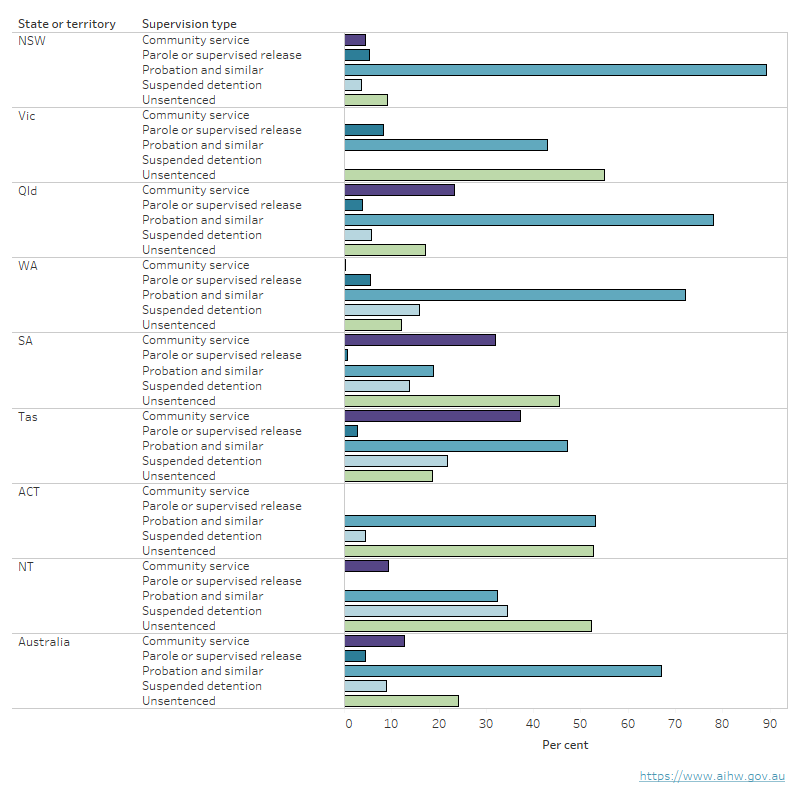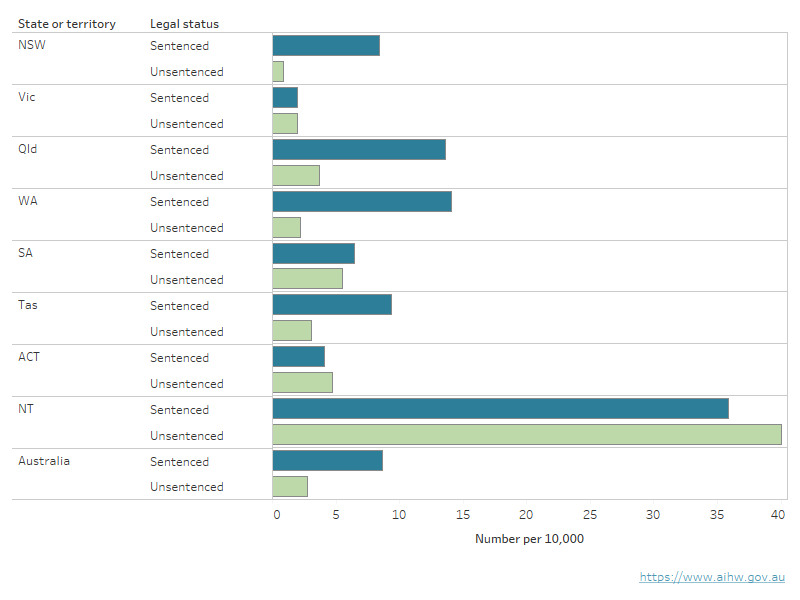Community-based supervision
On an average day in 2022–23, 82% (3,743) of young people aged 10 and over under supervision were supervised in the community; more than half of these (1,958, or 52%) were First Nations young people (Table S35a).
Of all young people under community-based supervision on an average day aged 10 and over, about 1 in 4 (24%) were on unsentenced orders and more than 8 in 10 (82%) were on a sentenced order.
A total of 7,934 young people were under community-based supervision at some time during the year (Table S64).
In 2022–23, the rate of First Nations young people aged 10–17 in community-based supervision on an average day was 103 per 10,000, compared with 4.8 per 10,000 for non‑Indigenous young people (Table S45a). This means First Nations young people aged 10–17 were about 22 times as likely as their non-Indigenous counterparts to be under community-based supervision on an average day.
Young people who are supervised in the community may be on unsentenced or sentenced orders, and may be on multiple orders of different types at the same time. Community-based supervision may be interrupted by time spent in detention due to another offence or a breach of a supervised release or parole order.
In this section, proportions should be interpreted with caution, especially in the smaller jurisdictions as they may represent a very small number of young people.
Unsentenced community-based supervision
Unsentenced community-based supervision orders include supervised bail (also known as conditional bail) and other orders such as home detention bail.
Supervised or conditional bail is where a young person is released into the community while awaiting the outcome of court action, and may include conditions such as supervision, a curfew or a monetary bond. Information about unsupervised bail is not available in the YJ NMDS.
In 2022–23, 24% of young people aged 10 and over who were under community-based supervision on an average day were on unsentenced orders (Table S64a; Figure 4.1).
Almost 1 in 4 (24%) First Nations young people aged 10 and over who were under community-based supervision on an average day were on unsentenced orders. This compares with 25% for non-Indigenous young people (Table S64a).
Among the states and territories, the proportion of young people under community-based supervision on an average day who were unsentenced ranged from 9.0% in New South Wales to 55% in Victoria (Table S64a; Figure 4.1).
Figure 4.1: Young people aged 10 and over who were under community-based supervision on an average day, by type of supervision and State or territory, 2022–23
This horizontal bar chart shows that ‘probation and similar’ was the most common type of community-based supervision in all states and territories, except for Victoria, South Australia and the Northern Territory.

Notes
- Numerators are the number of young people on a particular community-based supervision order on an average day in each state and territory. Denominators are the total number of young people on all orders in each state and territory.
- Unsentenced community-based supervision orders include supervised bail (also known as conditional bail), and other orders such as home detention bail.
- Under the Young Offenders Act 1994 (WA), Western Australia does not operate with the terms ‘probation and similar’ or ‘suspended detention’, so these data should be interpreted with caution. For Western Australia, orders reported under ‘probation and similar' consist of intensive youth supervision orders, youth community-based orders and adult community-based orders. Orders reported under ‘suspended detention’ include intensive youth supervision orders with detention.
- Components might not sum to the total as young people might have been under supervision for multiple types of orders on the same day.
- These data exclude young people under other types of orders.
Source: Table S60.
Nationally, 2 in 5 (40%) young people aged 10 and over who were under community‑based supervision during 2022–23 were on unsentenced community-based orders at some point during the year (Table S64b), with no difference evident in the data between the proportion of First Nations and non-Indigenous young people (40%). The difference between the proportion on an average day and during the year reflects the relatively short duration of unsentenced orders compared with sentenced orders.
The national rate of young people aged 10–17 under unsentenced community-based supervision on an average day was 2.7 per 10,000. Among the states and territories, rates ranged from 0.8 per 10,000 in New South Wales to 40 per 10,000 in the Northern Territory (Figure 4.2).
The national rate of First Nations young people aged 10–17 in unsentenced community‑based supervision on an average day was 27 per 10,000. For the states and territories where data were available, the rate ranged from 9.5 per 10,000 in New South Wales to 87 per 10,000 in the Northern Territory. For non-Indigenous young people, the national rate was 1.2 per 10,000, which ranged from 0.3 per 10,000 in New South Wales to 3.8 per 10,000 in the Australian Capital Territory (Table S66a).
Figure 4.2: Young people aged 10–17 under community-based supervision on an average day, by legal status and State or territory, 2022–23
This horizontal bar chart shows the rate of sentenced community-based supervision was substantially higher than the rate of unsentenced community-based supervision across most states and territories. Nationally, 8.7 per 10,000 young people under community-based supervision were sentenced compared to 2.7 per 10,000 who were unsentenced.

Note: Age on an average day is calculated based on the age a young person is each day that they are under supervision. If the age of a young person changes during a period of supervision, the average daily number under supervision will reflect this. Average daily data broken down by age will not be comparable with data in Youth justice in Australia releases before 2019–20.
Source: Table S66a.
Community-based supervision orders may end because:
- the specified term was successfully completed
- a sentence was handed down (for unsentenced community-based supervision, such as bail, only), or
- for other reasons, including because the young person breached the conditions of the order, or the order was varied or cancelled.
Where more complex cases are considered by the courts, sentencing decisions can take time, leading to extended or repeated bail orders. This also has an impact on how unsentenced community-orders are ended.
In 2022–23, 59% of unsentenced community-based orders ended because they were successfully completed (Table S68). This ranged from 8.4% in the Australian Capital Territory to 98% in Victoria.
The lower number of ‘successfully completed’ orders in the Australian Capital Territory is a result of young people on bail experiencing repeated bail orders due to the complexity of their cases. The very small numbers of young people on bail orders in the Australian Capital Territory reflect a group of high-risk young people.
Just under three-quarters (72%) of successfully completed unsentenced orders lasted less than 3 months, with the proportion ranging from 52% in South Australia to 84% in Western Australia (Table S68). Tasmania and the Australian Capital Territory are excluded due to the suppression of small numbers.
Sentenced community-based supervision
In 2022–23, more than 8 in 10 (82%) young people aged 10 and over who were under community-based supervision on an average day were on a sentenced order (Table S64a).
More than 8 in 10 (83%) of First Nations young people aged 10 and over who were under community-based supervision on an average day were serving a sentence. This was 80% for non-Indigenous young people (Table S64a).
Similar proportions of young people were under sentenced community-based supervision during the year (Table S64b).
The rate of young people aged 10–17 who were under sentenced community-based supervision on an average day was 8.7 per 10,000. Among the states and territories, the rate was lowest in Victoria (2.0 per 10,000) and highest in the Northern Territory (36 per 10,000) (Figure 4.2).
The rate of First Nations young people aged 10–17 in sentenced community-based supervision on an average day was 84 per 10,000. For the states and territories, this ranged from 19 per 10,000 in the Australian Capital Territory to 140 per 10,000 in Western Australia. For non-Indigenous young people, the national rate was 3.9, ranging from 1.5 per 10,000 in the Northern Territory to 7.2 per 10,000 in Tasmania (Table S66a).
Probation and similar orders
Probation and similar orders involve supervision by a youth justice agency for a specified period. Young people under these orders are often required to report to the agency regularly and be involved in treatment programs.
On an average day in 2022–23, more than two-thirds (67%) of young people supervised in the community were serving a probation or similar order (Figure 4.1). This ranged from 19% in South Australia to 89% in New South Wales.
In 2022–23, more than 4 in 5 (82%) probation and similar orders (see Glossary) that ended were successfully completed (Table S69). This proportion was lowest in the Australian Capital Territory (19%) and highest in Victoria (94%).
More than two-thirds (74%) of successfully completed orders lasted less than 12 months and the remainder for 12 months or more.
About 1 in 10 (11%) probation and similar orders ended due to a breach of conditions (Table S70). This proportion was lowest in South Australia (2.7%) and highest in Western Australia (24%).
Suspended detention
Under a suspended detention order, the young person remains in the community, as long as they do not breach conditions of the order or re-offend within a specified period. If the order is breached, they may be placed in detention.
On an average day in 2022–23, 8.8% of young people under community-based supervision were serving a suspended detention order (Figure 4.1). This proportion was highest in the Northern Territory (35%).
Among the states and territories where data were available and that had suspended detention orders during 2022–23, the proportion that ended because they were successfully completed was highest in Queensland (62%) and lowest in the Northern Territory (36%) (Table S71).
Parole or supervised release
Parole or supervised release refers to supervision within the community after a period of detention.
On an average day in 2022–23, 4.4% of young people under community-based supervision were on parole or supervised release (Figure 4.1). This proportion was highest in Victoria (8.2%).


